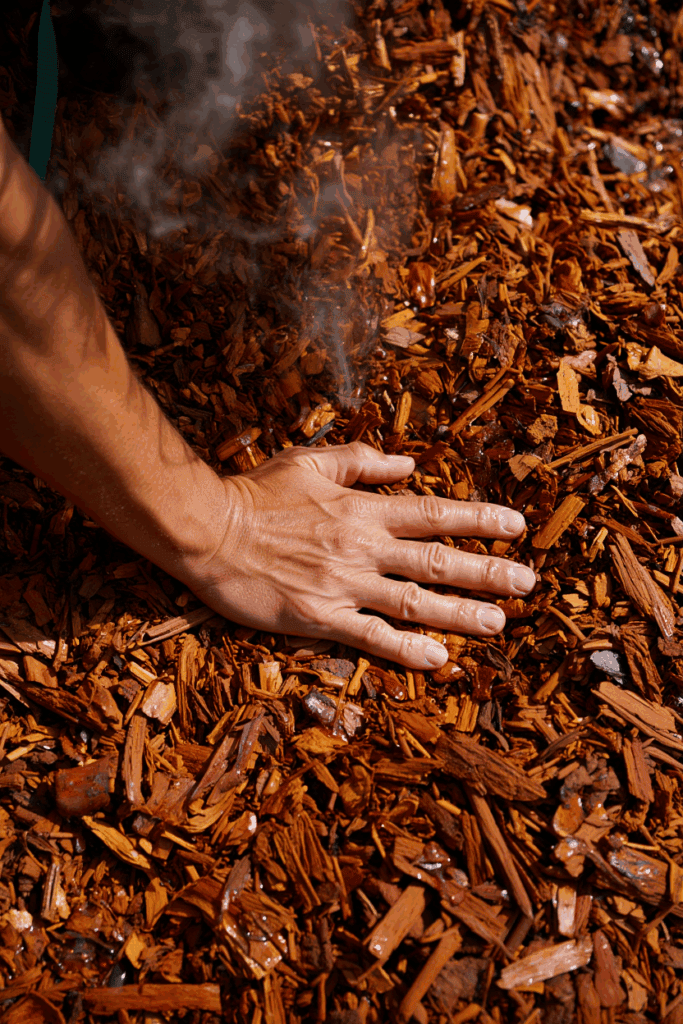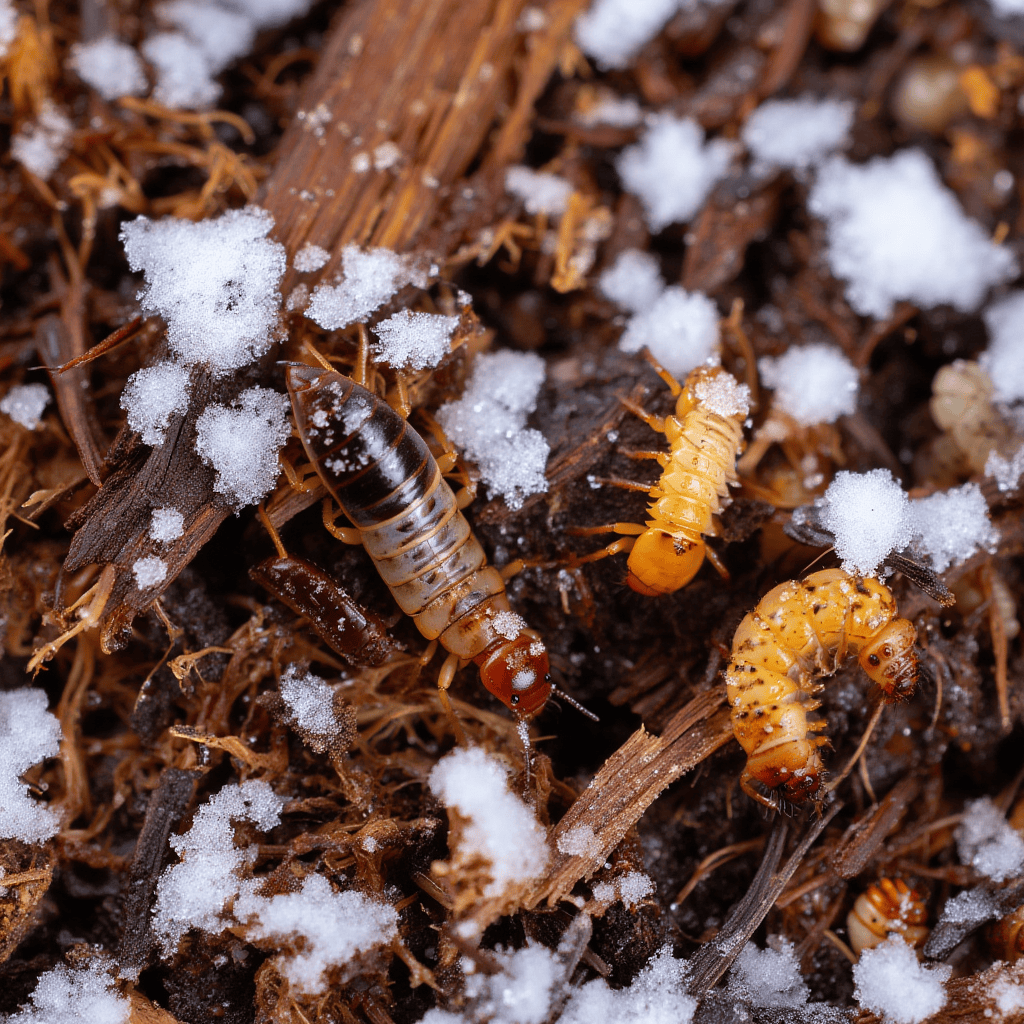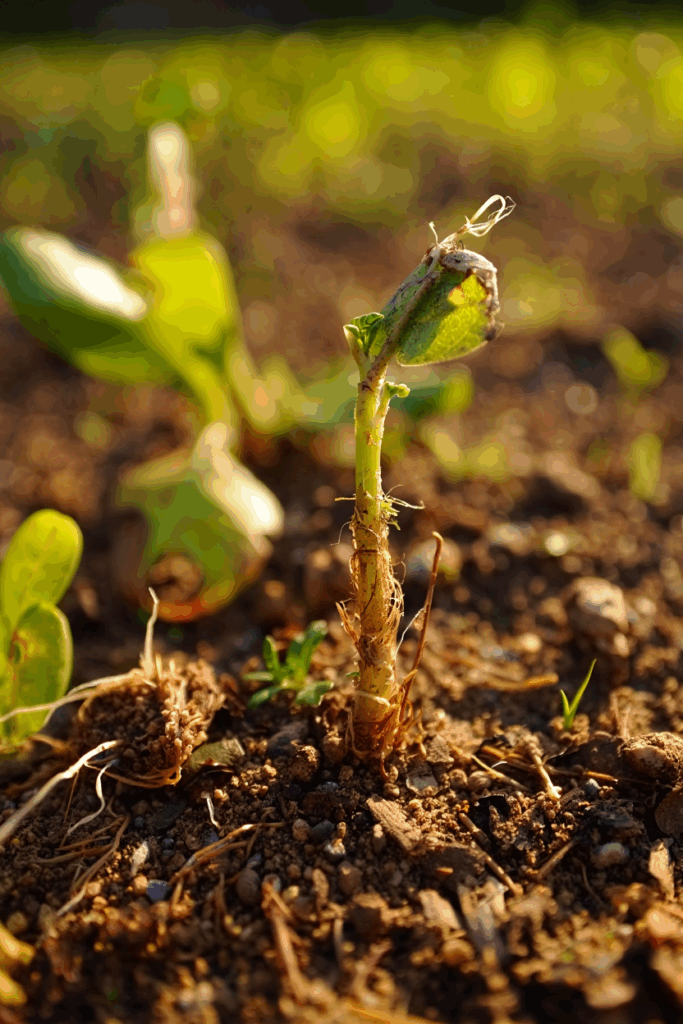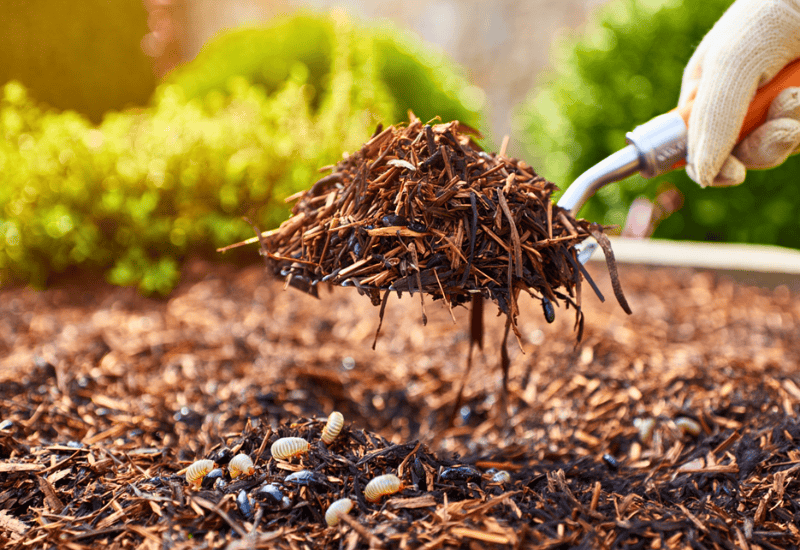By late autumn, most gardens look peacefully retired. The leaves are gone, the air feels still, and that neat layer of mulch you spread seems to signal the end of the season — a quiet pause before renewal. Everything looks asleep, wrapped up and waiting for spring.
But down where the air doesn’t reach and the frost can’t bite, the soil tells a different story.
It’s not silence — it’s movement. Slow, hidden, determined.
Earwigs fold themselves deep between wood chips and damp leaf bits. Vine weevils burrow close to roots, their pale grubs feeding quietly in the dark. Beetle larvae twist in the half-frozen soil, storing up energy for spring. Every handful of mulch becomes a tiny shelter — warm, moist, and perfectly safe from predators or weather.
You wouldn’t notice it from above. The surface looks tidy, even protective — a sign of good gardening. But underneath, it’s a layered city of life, one that doesn’t sleep just because the garden does.
This is the irony every gardener learns eventually: the same mulch that guards your plants from frost can also shield the things that want to eat them. And by the time you realize what’s been nesting below, the damage is already underway.
So if your garden seems still this winter, don’t mistake that stillness for rest. Sometimes, quiet soil isn’t resting — it’s plotting.
The Cozy Mistake We All Make

Most of us spread mulch in autumn with good intentions — to keep roots insulated, conserve moisture, and shield tender plants from frost. It feels responsible.
But when mulch stays thick and damp through the cold months, it can also offer shelter to a few unwanted guests — earwigs, vine weevils, and soil grubs — alongside the beneficial life we want to protect. A little winter aeration keeps the balance, allowing mulch to protect your plants without becoming a pest refuge.
Just a few inches of damp mulch pressed down after rain traps humidity. Without disturbance during winter, pests thrive—laying eggs, hiding, and surviving under the undisturbed blanket. Come spring, their activity erupts—seedlings vanish, and soil feels soft where roots should anchor tight. The problem started months ago, tucked away beneath your care.
The core issue is how mulch is used—left undisturbed, it turns from protector to incubator.
How the Hidden Army Builds All Winter Long

Once the soil dips into winter’s cold grip, pests continue their underground work—out of sight but not out of action. Earwigs curl into lower mulch layers, larvae and weevils burrow safely near roots, eggs nestled among bark and leaves hatch gradually. Slight activity persists, barely noticeable.
Late winter sees their growth accelerate. Pests fatten and prepare to emerge once the soil warms. When you see wilting seedlings in early spring, the invasion was quietly brewing all winter—an unseen cycle of feeding and survival.
Most gardeners blame poor soil, old seeds, or watering issues. Few realize the root cause: months of pests nestled under still mulch, cleverly outsmarting the cold. Awareness is key to breaking this cycle before damage occurs.
The Spring Reveal — When Silence Turns to Damage

Spring arrives softly. The soil softens, shoots push through, and beds look fertile again. Yet, beneath the surface, trouble lurks. Seedlings suddenly vanish, stems hollow out, and leaves appear chewed from below. When you poke the soil, it feels oddly soft—dangerous pockets where roots should be firm.
And there they are—pale grubs, earwigs darting away from sunlight, hiding in damp mulch that never blew away. Your winter protection secretly became a sanctuary for these pests. Slowly, your garden falls victim, not to neglect, but to silence and stillness hiding in plain sight.
This is the moment to act. The key? Turn the mulch—disrupt their habitat, expose them to light and air, and prevent their spring resurgence.
Don’t Panic — Just Turn the Tables (Literally)

You don’t need chemicals or drastic measures. The solution? Turn the mulch. On a dry, mild winter day (above 10°C/50°F), gently fluff the mulch with a garden fork or gloved hands. Toss it around to expose the bottom layers to sunlight and fresh air. This simple act will dry out pests and make the environment hostile for their survival.
Before replacing the mulch, sprinkle natural barriers like neem cake, diatomaceous earth, or wood ash. These act as repellents and dehydrators—harmless to beneficial insects and your plants.
Keep the mulch thin—no more than 2 inches—so it protects roots without locking in humidity. This isn’t guesswork — moderate turning and maintaining a thin 2-inch layer are practices long recommended by horticultural extension programs. It’s the balance professional gardeners rely on: enough mulch to protect, not enough to suffocate.
When the top feels dry but soil remains cool underneath, you’ve done it right. This quick, inexpensive ritual can save you months of spring frustration.
For larger beds, rotate sections over several weeks. This gradual disruption prevents pests from re-establishing tunnels all at once.
What to Use, What to Skip — Mulch That Defends, Not Harbors

Once you’ve turned and aired the mulch, ensure it remains effective. Not all mulches behave equally under winter conditions. Some breathe and dry, others trap moisture and decay into pest-friendly environments.
Opt for mulch that decomposes slowly and stays loose—aged bark, leaf mold, or pine needles in moderation. Avoid fresh grass clippings, kitchen compost, or dense sawdust, which trap heat or compact into layers that pests can tunnel through.
Remember, mulch isn’t permanent. Replace it every two years to prevent it from becoming a dense, pest-laden mat. For extra defense, tuck in aromatic herbs like rosemary, thyme, or lavender; their scent can repel earwigs and weevils while attracting beneficial insects.
Build a Natural Patrol Beneath the Layers

Healthy gardens maintain balance. Once the shelter is broken, the garden’s natural predators—birds, frogs, and ground beetles—step in. Birds swoop in, pecking at pests, while frogs and toads hunt at night. Ground beetles thrive in undisturbed soil, feeding on larvae and soft-bodied insects that damage roots.
Attract these allies by leaving loose mulch, providing hiding spots, and avoiding chemical insecticides. Scatter herb trimmings to confuse pests and bolster natural defenses.
This gentle coexistence promotes a resilient, balanced garden—one that naturally keeps pests in check without harsh treatments.
The Seasonal Rhythm That Keeps Pests in Check

A strategic routine makes pest control effortless:
Follow this cycle each year, and the garden will adapt and self-regulate. No frantic treatments or heavy chemical use needed—just steady, seasonal care.
The Quiet Lesson Beneath the Soil

The key is observation. Rest doesn’t mean absence of activity—sometimes, it’s hiding and plotting. Mulch itself is neither villain nor hero; it reflects how we care for the soil underneath. When left undisturbed, it gathers life—both good and bad.
A simple walk with a fork, lifting a patch of mulch, and letting sunlight in can reset the soil’s balance. Sometimes, care is about letting the earth breathe, not adding more.
In the end, whether your mulch protects or feeds your enemies depends on your mindful actions. Turning the mulch is more than a gardening tip—it’s a way to reclaim control over your garden’s health and future.

